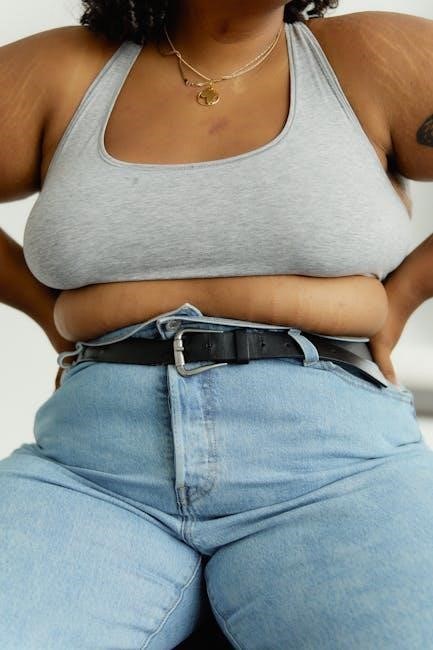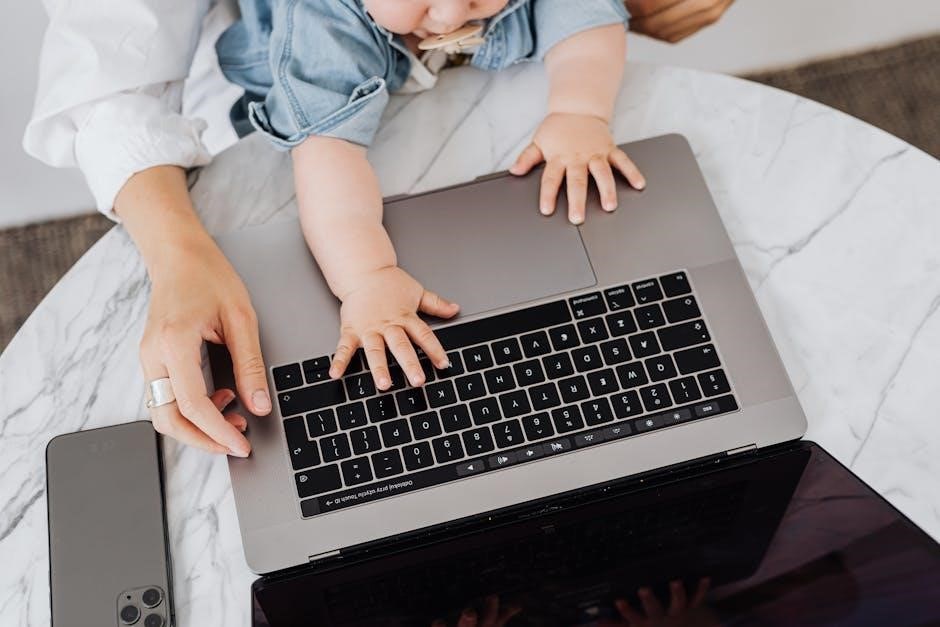
belt guide size
A proper-fitting belt enhances comfort and style‚ but many confuse belt size with pant size. This guide helps navigate sizing systems to ensure the perfect fit.
1.1 Importance of Proper Belt Fit
A well-fitting belt is essential for both comfort and style. It ensures your pants stay securely in place without causing discomfort or restricting movement. A belt that is too tight can dig into your waist‚ while one that is too loose may not hold your pants properly. Proper fit also extends the life of your belt by preventing excessive strain on the material. Additionally‚ the right size ensures the buckle aligns correctly‚ maintaining a polished appearance. Whether for formal or casual wear‚ a correctly sized belt enhances your overall look and provides long-lasting durability.
1.2 Overview of Belt Sizing Systems
Belt sizing systems vary‚ with most using inches or centimeters. US belts typically use inches‚ while European systems prefer centimeters. Some brands offer alpha sizes like S‚ M‚ L. It’s important to note that these systems can differ between brands and regions. Always refer to the specific size chart provided by the manufacturer to ensure accuracy. This guide helps you navigate these variations‚ ensuring you find the perfect fit every time.

How to Measure Your Belt Size
Measure your natural waistline with a flexible tape measure‚ typically where pants sit. This provides an accurate baseline for determining your ideal belt size.
2.1 Measuring Your Waist for Belt Size
To determine your belt size‚ measure your natural waistline‚ typically where your pants sit. Use a flexible tape measure and ensure it’s snug but not tight. This measurement serves as your baseline. Note that belt sizes are usually 2-3 inches larger than pant sizes. For accuracy‚ measure in inches‚ as most belts are sized this way. If you don’t have a tape measure‚ you can use a pair of well-fitting pants and add 2-3 inches to their waist size. This method ensures a comfortable and proper fit for your belt.
- Measure around your natural waistline.
- Use a flexible tape measure for accuracy.
- Add 2-3 inches to your pant waist size if needed.
2.2 How to Measure an Existing Belt
To measure an existing belt‚ lay it flat and straighten it completely. Exclude the buckle and measure the strap from the tip to the middle hole‚ as this is the standard sizing point. If your belt has multiple holes‚ the middle one typically corresponds to your ideal fit. For accurate results‚ use a ruler or tape measure and note the length in inches. This method ensures consistency and helps determine your size when purchasing a new belt. Remember‚ belt sizes are usually 2-3 inches larger than pant sizes‚ so adjust accordingly for comfort and style.
- Lay the belt flat and straighten it.
- Measure from the tip to the middle hole.
- Exclude the buckle in your measurement.
Understanding Belt Size Charts
Belt size charts help determine the perfect fit by converting measurements into standard sizes. They vary by brand and region‚ using inches or centimeters for accuracy.
3.1 Standard Belt Size Chart for Men
A standard men’s belt size chart typically ranges from 28 to 44 inches‚ corresponding to small‚ medium‚ large‚ and extra-large sizes. Belt sizes are measured from the buckle to the middle hole‚ ensuring a comfortable fit. For example‚ a man with a 38-inch waist usually wears a 40-inch belt‚ as belts are generally 2-3 inches larger than pant sizes. The chart provides a clear reference‚ helping men choose the right size for their waist measurement. Accurate sizing ensures optimal comfort and style‚ whether for formal or casual wear.
3.2 Belt Size Chart for Women
A women’s belt size chart typically ranges from 24 to 40 inches‚ catering to various body types. Measurements are taken from the buckle to the middle hole‚ ensuring a snug fit. For instance‚ a woman with a 30-inch waist might wear a 32-inch belt‚ as sizes are usually 2-3 inches larger than waist measurements. The chart provides a straightforward guide‚ helping women select the perfect size for their needs. Whether for formal wear or casual outfits‚ accurate sizing ensures both comfort and style‚ making the chart an essential tool for confident belt selection.
3.3 Plus Size Belt Chart
A plus size belt chart offers extended sizing options‚ typically ranging from 38 to 50 inches or more‚ ensuring a comfortable and stylish fit for all body types. These charts cater to individuals with larger waist measurements‚ providing clear guidelines to avoid confusion. The sizes are usually measured from the buckle to the middle hole‚ similar to standard belts. Plus size belts often feature additional holes for adjustability‚ ensuring a secure fit. By referencing this chart‚ users can easily determine their ideal size‚ whether for formal or casual wear‚ and enjoy both comfort and confidence in their choice.

Belt Size vs. Pant Size
Belt size differs from pant size‚ typically being 2-3 inches larger to ensure a comfortable fit. This difference prevents the belt from feeling too tight or restrictive.
4.1 Why Belt Size Differs from Pant Size
Belt size differs from pant size due to design and functionality. Pants are tailored to fit snugly around the waist‚ while belts need extra length for buckles and adjustment. Typically‚ belts are 2-3 inches larger than pant sizes to accommodate the buckle and ensure a comfortable‚ secure fit. This sizing difference also accounts for varying waist shapes and ensures the belt can be fastened without feeling too tight or restrictive. Understanding this distinction helps in selecting the right belt size for optimal comfort and style.
4.2 How to Convert Pant Size to Belt Size
To convert pant size to belt size‚ add 2-3 inches to your pant size. For example‚ if your pant size is 32 inches‚ your belt size should be 34-35 inches. This accounts for the buckle and ensures a comfortable fit. Measure your natural waistline if unsure‚ as this provides the most accurate belt size. Refer to a size chart for precise conversions‚ as some brands may vary slightly. This method ensures your belt fits securely without being too tight‚ offering both comfort and style.
International Belt Size Conversion
International belt sizes vary‚ with the US using inches and Europe using centimeters. Use conversion charts to align your size across regions for a perfect fit.
5.1 US to European Belt Size Conversion
Converting US to European belt sizes involves understanding the difference between inches and centimeters. In the US‚ belts are measured in inches‚ while Europe uses centimeters. For example‚ a US size 32-inch belt corresponds to a European size 80 cm. To convert‚ add 2.54 to the US inch size to get the European centimeter size. Many brands provide conversion charts to simplify this process. However‚ some brands use standard sizes like S‚ M‚ L‚ which may differ from numerical sizes. Always refer to the specific brand’s chart for accuracy‚ as variations can occur. This ensures a perfect fit across regions and styles.
5.2 Inches vs. Centimeters in Belt Measurements
Belt sizes differ significantly between inches and centimeters‚ with the US favoring inches and Europe using centimeters. To convert‚ multiply inches by 2;54 to get centimeters. For example‚ a 32-inch belt equals 81.28 cm. While some brands use numerical sizes‚ others adopt standard labels like S‚ M‚ L. This dual system can cause confusion‚ so checking brand-specific charts is crucial. Understanding this distinction ensures accurate sizing‚ avoiding mismatches. Always verify the measurement system used by the brand to select the correct size‚ as variations in labeling can lead to errors if not properly addressed.
Factors Affecting Belt Size
Weight fluctuations and belt material impact size. Leather belts may stretch‚ while synthetic ones remain rigid. Activity levels and belt type also influence fit and comfort.
6.1 Weight Fluctuations and Belt Size
Weight changes can significantly affect belt size. Gaining weight may require a larger belt‚ while weight loss could mean downsizing. Leather belts may stretch over time‚ offering some flexibility. However‚ drastic fluctuations can render a belt too tight or too loose. Monitoring measurements regularly ensures the best fit. It’s important to consider these changes when purchasing or adjusting belts for comfort and style. Proper sizing remains key to both functionality and aesthetics‚ regardless of weight shifts.
6.2 Belt Type and Material Impact on Size
The type and material of a belt can influence its size and fit. Leather belts‚ for instance‚ may stretch over time‚ requiring a slightly smaller initial size. Synthetic materials‚ like nylon or polyester‚ retain their shape better and typically fit more consistently. Wide belts or those with bulky buckles may need a larger size for comfort. Additionally‚ stretch belts or elastic styles offer flexibility‚ accommodating minor size fluctuations. Understanding the characteristics of different materials and styles helps in selecting the most appropriate belt size for a precise and comfortable fit.

Choosing the Right Belt for Your Pants
Choosing the right belt involves matching the style to your pants. Formal pants require slim belts‚ while casual styles can accommodate wider or embellished designs.
7.1 Belt Size for Formal Pants
For formal pants‚ choosing the right belt size is crucial for a polished look. Measure your natural waistline‚ typically 2-3 inches larger than your pant size. Ensure the belt fits snugly without gaping. Formal belts are usually slimmer‚ so opt for a size that aligns with your waist measurement. Avoid oversized buckles to maintain elegance. Leather belts are ideal for formal settings‚ offering durability and sophistication. Refer to a size chart to match your waist measurement with the correct belt size‚ ensuring the buckle sits comfortably at the third hole for the perfect fit.
7.2 Belt Size for Casual and Jeans
For casual pants and jeans‚ belt size should complement comfort and style. Measure your waist or existing belt to determine the right size. Add 2 inches to your pant size for a relaxed fit. Consider stretch belts for added flexibility. Opt for wider belts to match the rugged look of jeans. Ensure the buckle aligns with the middle hole for a balanced appearance. Canvas or suede belts are great for casual settings. Always refer to the size chart to ensure accuracy. The perfect casual belt should feel comfortable while securing your pants securely‚ enhancing your overall laid-back style with ease and practicality.
Tips for the Perfect Belt Fit
Measure your waist accurately‚ consider belt stretch‚ and ensure the buckle aligns with the middle hole for optimal comfort and style; Size up if unsure.
8.1 When to Size Up or Down
When your waist measurement falls between two sizes‚ consider sizing up for comfort. If your belt frequently feels too tight‚ it’s time to size up. Conversely‚ if it consistently feels loose‚ size down. Pay attention to how the buckle aligns with the holes—ideally‚ it should sit in the middle. If you’re unsure‚ opt for the larger size‚ as belts can stretch slightly over time. Always prioritize comfort and functionality‚ ensuring your belt supports your pants without restricting movement. Adjusting your belt size appropriately ensures a perfect fit for both style and practicality.
8.2 Adjusting Belt Size for Comfort
Ensuring your belt fits comfortably is key to enjoying your outfit. If your belt feels too tight‚ consider loosening it slightly or sizing up. For belts with adjustable straps‚ leave a small gap when fastening to avoid restriction. Leather belts may stretch over time‚ so start with a snug fit and allow for natural break-in. Synthetic materials‚ however‚ won’t stretch‚ so choose a size that feels comfortable immediately. Test the belt with your usual clothing to gauge how it sits throughout the day. A well-adjusted belt should provide support without digging into your waist‚ ensuring all-day comfort and confidence.

How to Use a Belt Size Chart
Easily measure your waist or an existing belt‚ align with the chart‚ and consider brand variations for the perfect fit‚ ensuring comfort and style.
9.1 Matching Measurements to Chart
Once you’ve measured your waist or an existing belt‚ compare the measurement to the size chart. Ensure the number aligns with the correct column‚ considering whether the chart uses inches or centimeters. For example‚ a 34-inch waist typically corresponds to a belt size of 36 inches. Note that some charts may include size ranges‚ so select the closest match. If your measurement falls between sizes‚ consider sizing up for comfort; Always check if the chart is for US or European sizes‚ as they differ. This step ensures a precise fit‚ whether shopping online or in-store.
9.2 Interpreting Size Ranges
Size ranges on belt charts indicate the strap length from the buckle to the farthest hole. For example‚ a size 34 belt might range from 32 to 36 inches. To interpret correctly‚ match your measurement to the middle of the range for the best fit. If your waist is 34 inches‚ a belt sized 34-36 inches is ideal. If your size falls between two ranges‚ size up for comfort. Some charts use alphanumeric sizes (S‚ M‚ L)‚ so refer to the corresponding measurements. Always consider the material’s stretch and the buckle size when selecting. This ensures a comfortable and secure fit.

Common Mistakes in Belt Sizing
Confusing waist size with belt size and not accounting for belt stretch are common errors; Always measure accurately and consider material flexibility for the best fit.
10.1 Confusing Waist Size with Belt Size
One of the most common mistakes is assuming your belt size matches your pant size. However‚ belt sizes are typically 2-3 inches larger than waist measurements. This discrepancy arises because belts are measured from the buckle to the middle hole‚ not the waist directly. Additionally‚ materials like leather stretch over time‚ affecting fit. To avoid this error‚ measure your waist and add 2-3 inches for your belt size. Always refer to a size chart and consider the material’s flexibility for an accurate fit. This ensures comfort and prevents the belt from being too tight or too loose.
10.2 Not Considering Belt Stretch
Another common mistake is not accounting for belt stretch‚ especially with materials like leather. Over time‚ belts can stretch‚ causing them to loosen. This leads to a poor fit and potential discomfort. To avoid this‚ consider the material’s flexibility when choosing a size. For example‚ leather belts may stretch more than synthetic ones. Opting for a slightly snug fit initially can ensure long-term comfort. Always check the belt’s flexibility and adjust your size selection accordingly. Ignoring stretch can result in a belt that becomes too loose‚ compromising both functionality and style.
Belt Size Guide for Different Brands
Brands often have unique sizing due to varying measurement methods and materials. Always check the specific brand’s size chart for accurate fit‚ ensuring comfort and style.
11.1 Variations in Brand Sizing
Brand sizing varies significantly due to differences in measurement methods and materials. Some brands use inches‚ while others prefer centimeters. European brands often align with international standards‚ while US brands may differ. For example‚ LIÉ STUDIO uses European sizing based on centimeter measurements‚ whereas US brands typically use inches. Additionally‚ some brands offer standard sizes like S‚ M‚ L‚ which can vary widely. Always refer to the specific brand’s size chart‚ as their sizing may not align with universal standards. This ensures the best fit and avoids discrepancies. Using brand-specific guides is crucial for accuracy and comfort.
11.2 How to Check Brand-Specific Charts
To ensure accuracy‚ always consult the brand’s official size chart. Most brands provide detailed charts on their websites‚ outlining measurements in inches or centimeters. For example‚ LIÉ STUDIO uses European sizing‚ measuring from the buckle base. Compare your measurements to their chart to find the best fit. Some brands also offer size conversion guides‚ especially for international customers. Never assume universal sizing‚ as variations exist. If unsure‚ contact customer service for clarification. Using brand-specific charts ensures a tailored fit‚ avoiding the hassle of returns or adjustments. Always prioritize these guides for a seamless shopping experience.

Belt Care and Maintenance
Proper care extends belt longevity. Clean leather belts with a soft cloth and conditioner. Store them flat to maintain shape and avoid cracks. Regular maintenance ensures durability.
12.1 Cleaning and Conditioning Leather Belts
Cleaning and conditioning are essential for maintaining leather belts. Use a soft‚ dry cloth to wipe away dirt. For deeper cleaning‚ apply a small amount of leather conditioner or saddle soap‚ gently massaging it into the material. Avoid harsh chemicals or excessive water‚ as they can damage the leather. After cleaning‚ let the belt air dry naturally. Regular conditioning keeps the leather supple and prevents cracking. For stubborn stains‚ a leather-specific cleaner can be used‚ but always test a small area first to ensure no discoloration occurs. Proper care ensures your belt remains durable and stylish for years.
12.2 Storing Belts Properly
Proper storage is key to maintaining the quality and longevity of your belts. Store them in a cool‚ dry place away from direct sunlight to prevent fading or cracking. Avoid folding or bending belts‚ as this can cause creases or damage. Instead‚ roll leather belts gently and place them in a protective cloth or dust bag. For metal or buckle belts‚ ensure the buckle is secured to prevent scratching. Avoid extreme temperatures or humidity‚ as these can degrade materials. Proper storage helps preserve the shape‚ finish‚ and functionality of your belts‚ ensuring they remain in excellent condition for years to come.
Choosing the right belt size ensures comfort‚ style‚ and longevity. By measuring accurately‚ understanding size charts‚ and considering material‚ you can confidently select the perfect belt for any occasion.
13.1 Final Tips for Choosing the Right Belt
Always measure your waist accurately and consider adding 2-3 inches to your pant size for the perfect belt fit. Opt for high-quality materials like leather for durability. Ensure the belt style matches your outfit—formal or casual. Check brand-specific size charts‚ as sizing can vary. If unsure‚ size up for comfort. The buckle should align with the middle hole for an ideal fit. Avoid overly tight belts to prevent discomfort. Remember‚ belt sizes can change with weight fluctuations‚ so adjust accordingly. Investing in a well-fitting belt enhances both style and functionality‚ making it a worthwhile investment for your wardrobe.
13.2 Importance of Proper Fit for Longevity
A well-fitting belt not only enhances comfort but also extends its lifespan. A belt that is too tight can stretch or crack‚ while one that is too loose may wear out faster. Proper fit ensures even distribution of stress‚ preventing premature damage. Always align the buckle with the middle hole for optimal durability. Avoid over-tightening‚ as it can cause the material to degrade. Leather belts‚ in particular‚ benefit from proper fit to maintain their shape and finish. Investing in a belt that fits correctly ensures it remains a stylish and functional accessory for years to come.